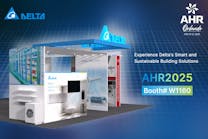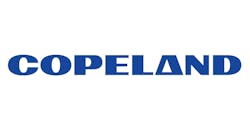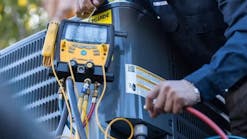Quiz: Refrigerant Recovery & Evacuation (Continued)
Jarboes Provides HVAC System to Local Teacher
BY JAMES BOWMAN
Most qualified contractors are knowledgeable of building codes for general HVAC work. However, many are unaware of five accessories that are mandated by building codes aimed at the fast-emerging ductless mini-split market.
Rather than learn what’s not code compliant from an inspector that red tags a new mini-split installation, the following list of code-mandated products are listed below:
1.Tamper-resistant locking cap for refrigerant ports
2. Condensate overflow switch
3. UV resistant wrap for linesets
4. Condensate drain hose trap
5. An indoor disconnect switch.
These accessories are mandated for a variety of reasons, but they mostly fall under life-safety, efficiency, property protection or a combination of those categories.
There are many codes and some can appear ambiguous; however both contractors and inspectors might add to this ambiguity due to lack of knowledge on some of the current mandates. Add the fact that all jurisdictions don’t adopt the same code criteria and the situation can become clouded. For example, the aforementioned accessories might fall under criteria from any number of code organizations, such as the International Code Council’s (ICC) International Energy Conservation Code (IECC); International Mechanical Code (IMC), International Residential Code (IRC); and the National Electrical Code (NEC) to name a few.
The following three reasons illustrate why installing contractors should know how these accessories fit into the codes:
- Many inspectors aren’t familiar with mini-splits, because the market segment hasn’t penetrated many jurisdictions, yet.
- Inspectors may be unfamiliar with some of the HVAC accessory products that have been instituted into two of the most popular codes, such as the International Mechanical Code (IMC) and the International Residential Code (IRC).
- Inspectors may not be familiar with mechanical codes altogether, thus they may be likely to require more information from the contractor.
All this uncertainty can lead to red tag inspections. Contractors may also find themselves defending an installation accessory even when it’s code compliant. This is why contractors should arm themselves with HVAC accessories and code compliance knowledge. The following is a checklist of code-mandated accessories an installer should include on every mini-split installation
1) Locking Caps—(Life-Safety and Efficiency). The International Residential Code (IRC) Section M-1411.6 and the International Mechanical Code (IMC) Section M-1101.10, has required locking caps for several years on newly installed mini-split units. However, recent code revisions to the 2015 IMC now include any existing unit where the refrigeration circuit has been opened for service, according to Section M-1102.3–Access Port Protection: “Refrigerant access ports shall be protected in accordance with Section 1101.10, whenever refrigerant is added to or recovered from refrigeration or air-conditioning systems”. This is due to the trend of teenagers inhaling “huffing” refrigerants, a shocking nationwide trend that has led to many deaths and impairment, according to the National Inhalant Prevention Coalition (NIPC) (www.inhalants.org), a public-private effort to promote awareness and recognition of the underpublicized problem of inhalant abuse. Ironically, the government has tough refrigerant restrictions and licensing for manufacturers, wholesale distributors, and onsite installation contractors who need EPA-certification; however a teen needs only to remove a service cap and depress an unprotected Schrader valve core for access to refrigerant. Therefore, one of the most serious liabilities facing an installing contractor today is the omission of a tamper-resistant locking cap on any outdoor air conditioning condenser's refrigerant access port that leads to a teen injury or death. There are many brands of locking caps, but only a few fall under the codes' commentary of requiring a "special tool" to gain access. It is unknown how locking caps using commonly-found, unrestricted devices such as spanner tools, valve core removers or Allen wrenches will be interpreted in a lawsuit, because code commentary uses the wording, "special tool." When in doubt, use locking caps that need special tools for access that are sold only to trades people at HVAC/R distributors.
2) Overflow Switch––(Property Protection). The IMC and IRC codes mandate an overflow switch must be mounted in the primary drain pan of any air conditioning installation that doesn't have a secondary drain, or has a secondary drain pan with the potential for overflow and property damage. Specifically, the IRC’s Section M1411.3.1.1–Water Level Monitoring Devices: “On down-flow units and other coils that don’t have secondary drain or provisions to install a secondary or auxiliary drain pan, a water level monitoring device shall be installed inside the primary drain pan. This device shall shut off the equipment served in the event that the primary drain becomes restricted. Devices shall not be installed in the drain line.” Some overflow switches come with many options, but the main function is a unit cut-off switch so it can't operate and continue producing condensate during an overflow incident. Thus, an overflow switch is an inexpensive insurance against property damage. There are many switches and price ranges to choose from, however newly-developed models using diagnostic LED lights operated by an onboard microprocessor and historical recordings of shut-off times are invaluable for troubleshooting and cost only a few dollars more than economy models.
3) Linesets UV Protection––(Efficiency). Some lineset insulation might not have built-in inhibitors to protect against the sun’s ultraviolet light (UV), and even insulation that does, can deteriorate from UV. Breached insulation can expose the copper tubing to ambient temperatures, thus the system efficiency eventually degrades. Adhesive tape, such as duct tape is not permitted. Therefore, a UV wrap is essential and required by the IECC R403.4.1– Protection of Piping Insulation: “Piping insulation exposed to weather shall be protected from damage including that caused by sunlight, moisture equipment maintenance and wind, and shall provide shielding from solar radiation that can cause degradation of the material. Adhesive tape shall not be permitted.” The wrap can also deter animals and insects from picking away the underlying foam insulation. Furthermore, threading linesets through jagged wall openings or cavities can ruin foam insulation on mini-split linesets even before unit start-up. Instead, the industry now offers malleable lineset coils especially designed for mini-splits in easily decoupled pairs with a durable white, non-friction, easy-pulling, UV-resistant insulation that won't rip or wear. They should pass any UV inspection criteria.
4) Drain Hose Trap––(Efficiency). A condensate drain hose should always include an inline waterless drain trap, which is now mandated by the IMC Section M307.2.4.1–Ductless Mini-split System Traps: “Ductless mini-split equipment that produces condensate shall be provided with an inline check valve located in the drain line, or a trap.” It’s an inexpensive and essential device for preventing insect, dirt, humidity and allergen infiltration. An inline trap uses a check valve strategy that allows condensate to flow out, however unwanted pests, summertime humidity or wintertime cold air can’t infiltrate the evaporator and the conditioned room. There are also code restrictions for the drain line material choice. For example, clear vinyl tubing should be avoided for gravity draining, because many types are prone to kinking. A better alternative is a corrugated, kink-resistant drain hose designed specifically for mini-splits. Also, a condensate drain line that runs through an unconditioned space, such as an attic, should use an insulated drain hose to prevent property damage from moisture formation. The IMC Section M1411.3.2 Drain Pipe Materials and Sizes: “Components of the condensate disposal system shall be ABS, case iron, copper, cross-linked polyethylene, CPVC, galvanized steel, PE-RT, polyethylene, polypropylene, PVC pipe or tubing. Components shall be selected for the installation’s pressure and temperature ratings. Joints and connections shall be made in accordance with the applicable provisions of Chapter 30. Condensate waste and drain line size shall be not less than 3/4-inch (nominal) diameter from the drain pan connection to the place of condensate disposal. Multiple pipes in a manifold configuration shall be sized in accordance with an approved method.
5) Electrical Disconnect––(Life/Safety). A surge protector for the entire system and a disconnect box also for the indoor unit should be installed in addition to the outdoor unit disconnect box. A disconnect for the evaporator of a mini-split is a vital safety feature and a NEC requirement. It prevents accidental activation while the service tech works on the evaporator’s electrical system.
Uniform Mechanical Code (UMC) 903.7 reads: Switches in Electrical Supply Line: “Means for interrupting the electrical supply to the air-conditioning appliance and to its associated cooling tower (if supplied and installed in a location remote from the air conditioner) shall be provided within sight of and not over 50 feet from the air conditioner and cooling tower.
James Bowman is the national technical manager--HVACR of Rectorseal LLC (www.rectorseal.com), Houston, which offers more mini-split installation accessories than any other manufacturer in the industry. Bowman is a former service tech for several HVACR service contractors. He is EPA-certified, NATE-certified, holds a Class A contractor license in Texas, and has installed and serviced dozens of ductless mini-splits representing most brands. Bowman can be reached at [email protected]









